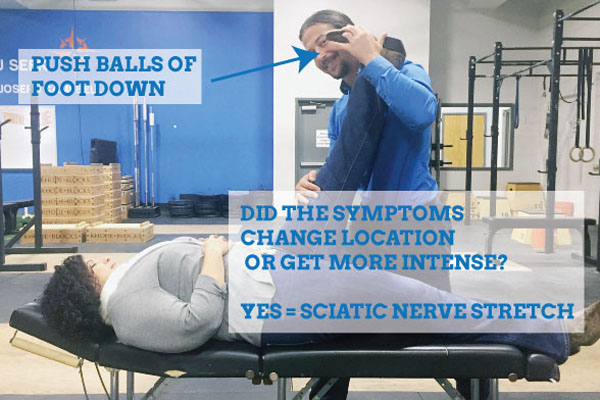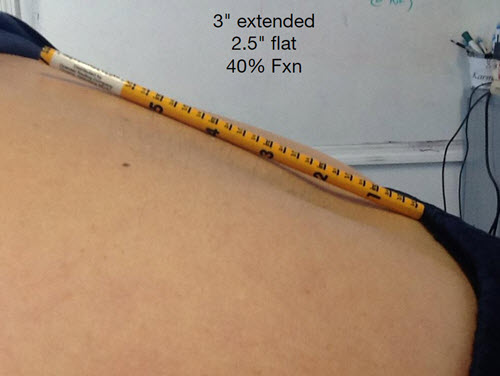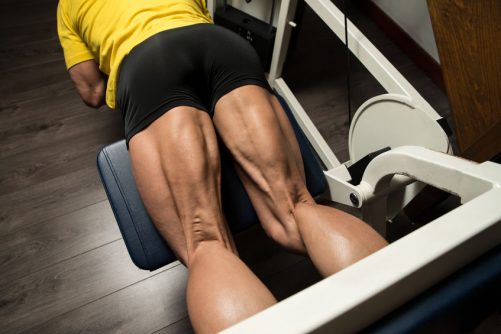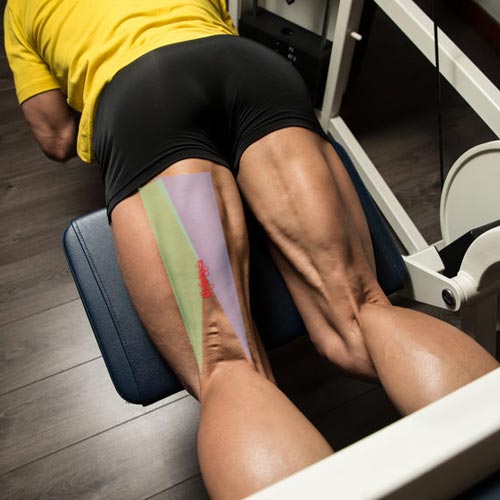Diy Massage for Pinched Nerve in Mid Back
28 Feb Stop Stretching Your Tight Hamstrings
Posted at 22:42h in Thigh 59 Comments
Tight hamstrings plague people. When you have tight hamstrings, you've had them for a really long time and it doesn't seem to matter how much you stretch, your tight hamstrings never get more flexible.
If your hamstrings were just "tight," your stretching interventions would've worked by now.
I'm going to share with you a little secret that will change your life when it comes to your tight hamstrings.
That secret is …
Your Hamstrings Aren't Tight
Everything should be made as simple as possible, but no simpler. ~Albert Einstein
This is an occasion where "tight" hamstrings is too simple. If it were that simple, the tightness would've gone away by now.
"Tightness" is more complex than that.
Normal muscle tightness gets better within a 1-2 months of stretching. Heck, you don't even need to stretch to get more flexible if this were the case. You'd only need to be doing fuller range of motion movements to get rid of that tightness.
What are fuller range of motion movements?
Squat ass-to-grass, lunge with your trailing leg's butt cheek fully squeezed, press a barbell overhead, or hang from the pull-up bar. When I was learning to squat as low as possible, the Cossack Stretch (see below video) helped me gain range of motion I never had before. I didn't even have a set, rep, or goal for doing the Cossack Stretch over the first few months I was CrossFitting.
Just doing it, without any structure, made me more flexible rather quickly.
Let's agree, right now, that if you've been stretching more than a month, no matter how much you've been shotgunning, foam-rolling, lacrosse-balling, stretching on your own or having your friends try to turn you into a pretzel, that what you have been doing isn't working.
Capiche?
Your tight hamstrings are a bit more complex than that.
Possible Problem #1: Your Sciatic Nerve is Tight
Go ahead and get your stretching friend right now. We're going to do one part of the hamstring stretch test.
Have your friend lift your leg like they're stretching your hamstring.
Then, when you're feeling a good "stretch" in any location, have them push the ball of your foot down about 1″ (like in the image below), nothing more than that.

If the "stretch" in your hamstring got more intense when your toes were pushed down, you, my friend, have a sciatic nerve problem.
Even though it feels like your hamstring is tight, what you're actually feeling is a hamstring contraction message sent by your brain to protect your sciatic nerve. Because nerves don't like being pulled tight and they'll protect themselves any way they can.
What You Need to Do: All we know is that your sciatic nerve is angry and fired up. The location where it is glued and stuck can be your low back, your butt, or your hamstrings. In order to figure out where, I recommend you find a reputable adhesion-removal provider to fix this.
If you live in North Jersey, Barefoot Rehab is the only practice certified in the area to find and fix adhesion. Call us at 862-205-4847.
You might be thinking:
Stretching at least allows me to continue doing what I'm doing. Why shouldn't I stretch my hamstrings?
The short answer is, "You're allowing your problems to grow bigger, under the radar."
Tricking the nervous system only works in the short-term. That's why the tightness you have that goes away with stretching and after workouts returns when you wake up the next morning.
Possible Problem #2: Your Low Back is Injured and Your Hamstrings are Contracting, Which You Feel as "Tight"
Here's a video (4:26 seconds long) of a patient of ours who was getting physical therapy for tight hamstrings when he came into our office and we diagnosed him correctly and proceeded to fix his hamstring pain in 6 treatments.
Tell your friend to go get his favorite pencil.
We're about to do the most complex, most sophisticated, elaborate test for the low back that exists in the history of the world, the pencil test, aka, as it's known in the yoga world, the Cat-Cow Test.
Have your friend put the pencil right on the midline of your low back.
If your friend sees a space under the pencil like there is under the 2″ mark on the pencil ruler below, it's safe to assume your hamstrings are tight because your low back is functioning at 40% (or less) of its potential.

What You Need to Do: If that's you, I hope that you had an acute low back injury in the last week or so. It's possible this range of motion will get better all on it's own.
If you haven't had a low back injury recently, then you need to find a reputable adhesion-removal provider to fix this. You could try doing 1,000 repetitions of the cat-cow per day, but I've never seen someone gain this range of motion back in the low back with stretching.
Possible Problem #3: The Adhesion in Your Hamstrings Is Tight
If you passed problems #1 and #2, then by default, you probably fall into this category.
I assume you did the hamstring stretch test and the pencil test and you passed both according to the standards we set in this post.
Good.
Still, you probably have been stretching for more than 1-2 months without a permanent improvement.
You don't have a sciatic nerve issue. You don't have a low back issue.
Then, what is it?
The most straight-forward and easiest problem for a reputable adhesion-removal provider to fix is adhesion in your hamstrings.
Check out this bodybuilder. The good thing about bodybuilders is that it's easy to see the outline of their muscles.

There are three individual muscles that make up the hamstrings. Two make up the inside hamstrings (the blue triangle below), and one makes up the the outside hamstring muscle (the green triangle).
You can probably envision, in your mind's eyes, the need for the blue and green hamstring muscles to slide and contract past each other. When adhesion (the red squiggles) glues the muscles together, the hamstrings can't slide and contract past one another.

When you stretch, you lengthen all of the healthy parts of the muscle instead of the precise location (the adhesion) that needs to be stretched.
What You Need to Do: The good thing about adhesion in the hamstring is that your risk of injury is lower than if you had problems #1 and #2 and you don't want to do anything about it. The bad news is that the adhesion isn't going anywhere unless you find a reputable adhesion-removal provider to fix this.
What if you don't want to see a doctor or provider to help you with your tight hamstrings?
Unfortunately, tight hamstrings requires that you see someone to fix it.
If you don't want to fix your tight hamstrings but you want to stay active, stretching can allow you to be active without injuring your hamstrings in the short-term. But there's a cost to going this route. The cost is that your problem will get worse faster and more exponentially over the next few months to years than if you didn't use it.
My primary recommendation if you don't want to get it fixed is that you:
- don't stretch.
- don't provoke any hamstring or low back symptoms of any kind.
Symptoms includes sensations such as pinching, ache, dullness, sharpness, throbbing, and other sensations that you can't describe with words. Soreness is OK, as long as it's equal on both sides.
If you do a workout and you feel no sensation of worsening, that was a good, low-risk workout.
If you do a month of works and you feel no worsening, that was a good month. There's lower risk of injury progressing over time.
As soon as you do movements or workouts that intensify soreness on one side or give you the funny feeling of the hamstrings feeling different, then you're walking in risky territory.
Just stop fooling yourself by stretching and thinking your tight hamstrings are going to get better or more flexible. They're not.
Fixing chronic pain is not simple or easy. If it were, the pain would be fixed already.
You can see the level of detail we go into with a patient with chronic hamstring tendonitis below:
In summary, the secret to that will change your life when it comes to tight hamstrings or anything that you're doing that isn't producing results is to simply:
Stop doing stuff that isn't working.
Again, to quote Albert Einstein:
Insanity is stretching (or foam rolling) your tight hamstrings month after month, year after year, with no improvement … only to stretch some more.
 What's the deeper cause of your tight hamstrings? How long have you been stretching your tight hamstrings? Feel free to share in the comments below.
What's the deeper cause of your tight hamstrings? How long have you been stretching your tight hamstrings? Feel free to share in the comments below.
Dr. Chris Stepien, DC, Full-Body ID Certified, ART Certified, CSCS, and CrossFit Level 1 Certified, fixes your annoying and frustrating pains, even when it's been over 6 months and you've seen 3-5 other doctors or therapists without lasting relief Barefoot Rehab in Denville, NJ. And when you're sad, depressed, or not enjoying life, Dr. Chris wants to hug you. He invites you to reach out, no matter what your concern is. Barefoot Rehab is here to serve you.
Diy Massage for Pinched Nerve in Mid Back
Source: https://www.barefootrehab.com/stop-stretching-tight-hamstrings/
0 Response to "Diy Massage for Pinched Nerve in Mid Back"
Post a Comment